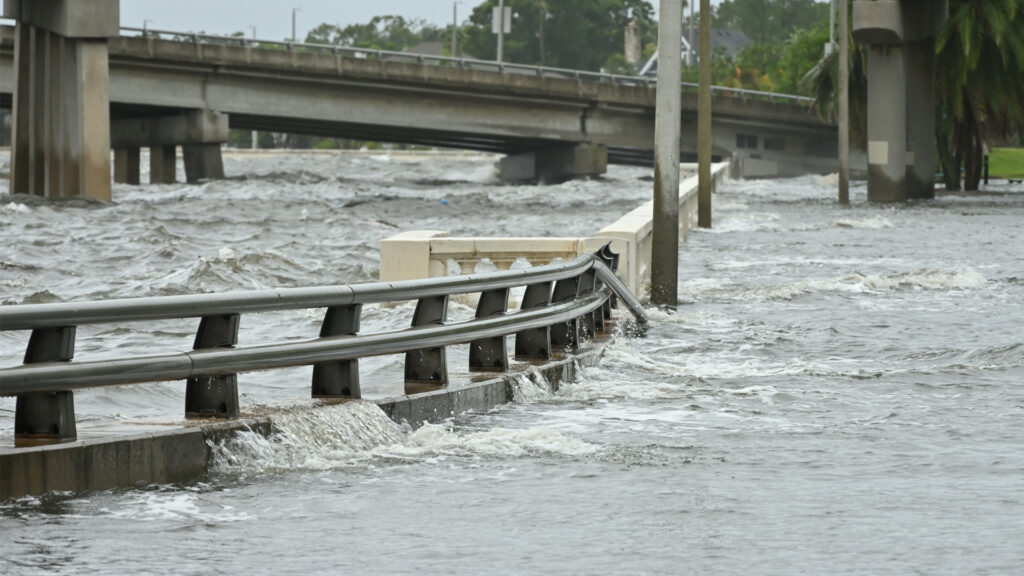By Gary T. Mitchum, USF College of Marine Science
Those of us in the Tampa Bay area have always been aware of the risks of flooding, but we are now learning that these risks are increasing as the climate warms. The most obvious threat is due to sea level rise.
As the surface of the Earth warms, ice on land melts and flows into the oceans, causing average sea level around the world to rise. The surface temperature increase also warms the ocean, causing more sea level rise because warm water is less dense and takes up more space.
Due to the combined effects of ice melt and ocean warming, over the 20th century the average sea level rose by 6 to 8 inches, or about 2 inches on average each 25 years. What worries the scientists, though, is that the rate of sea level rise is increasing. In the first 25 years of the 21st century, sea level rose an additional 3 to 4 inches, and climate models predict that the next 25 years will most likely bring another 5 to 8 inches.

Here in the Tampa Bay area we are also aware of more frequent flooding of our streets at high tide. These events are occurring more often as the tide adds on top of the increasing mean sea level. Most people who live near the coast know about the spring tides that occur during the full moon and new moon, when the high tides are higher than normal.
Many people may not know, however, that the height of the spring tides also changes from year to year and from decade to decade. Because of these natural changes, our spring tides have been lower than average in recent years and are now increasing.
When these natural changes are added to the increasing mean sea level, we find that the frequency of these high tide flooding events will be increasing rapidly over the next decade. In a study that I co-authored a few years ago, we found that the frequency of these events in the Tampa Bay area will increase from less than 10 events per year to nearly 70 events per year.
Increasing air temperature also increases the risk of flooding due to extreme rainfall events that produce more rain than the drainage system can handle. The reason for this increase has been understood for a long time. Warmer air simply holds more water, and for an increase in temperature of about 1° Celsius (1.8° Fahrenheit), the air will hold 7% more water, meaning that the potential volume of rain released in a storm increases by 7%, too.
People in the Tampa Bay area might remember the flooding at the Vinoy Renaissance St. Petersburg Resort & Golf Club parking garage in 2019 caused by a very strong rainstorm. And more recently most of us witnessed the consequences of an extreme rainfall event in Fort Lauderdale.
In response to these increasing flood risks, the state established the Florida Flood Hub for Applied Research and Innovation at the University of South Florida’s College of Marine Science to provide scientific and technical guidance to improve flood forecasting and to inform science-based policy, planning and management practices.
The Flood Hub has created two work groups with more to come. The first work group is providing guidance on future sea level rise and high tide flooding, and the second will consider future changes in extreme rainfall events. The first work group looked carefully at the sea level rise results provided by the Intergovernmental Panel on Climate Change and the U.S. federal task data that translated these results to the U.S. coastline.

The work group in turn translated these results to the Florida coastline. Florida is most likely to experience an additional 5 to 6 inches of sea level rise between 2020 and 2040, and 13 to 18 inches between 2020 and 2070. The first work group is now busy working on the high tide flooding problem, and the second work group is working to quantify the future risk from extreme rainfall events.
Much of this is alarming, I know, but I would suggest that the future is more promising. In the past decade the estimates of future greenhouse gas emissions have decreased. The estimates for the flooding risks I’ve discussed above have also decreased. Not a lot, I admit, but I think it’s encouraging that the tide appears to be turning.
Communities around the world, including here in Florida, are taking steps to adapt and increase resiliency by reducing emissions. We’re not done with this problem by far, we’re just beginning, but our efforts are starting to make a difference. I for one am hopeful.
Gary T. Mitchum has been a faculty member in the College of Marine Science at the University of South Florida since 1996 and is now associate dean for research at the college. Before arriving at USF, Mitchum was director of the University of Hawaii Sea Level Center, where he developed an interest in sea level rise. This opinion piece was originally published by the Tampa Bay Times, which is a media partner of The Invading Sea.
If you are interested in submitting an opinion piece to The Invading Sea, email Editor Nathan Crabbe at ncrabbe@fau.edu. Sign up for The Invading Sea newsletter by visiting here. To learn more about sea level rise, watch the video below.



